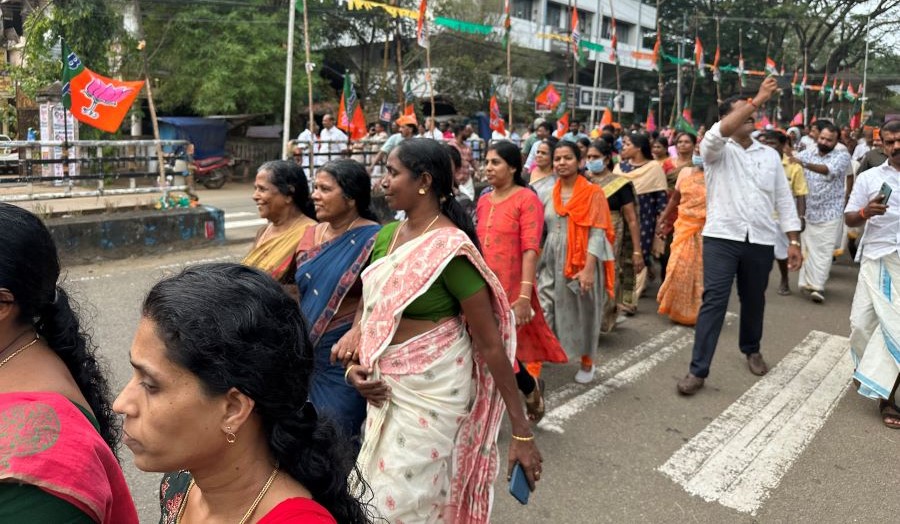BY MOHANAN NAIR
As the Indian Parliamentary election draws nearer, the political landscape is ablaze with activity. Despite the official announcement of poll dates pending from the Election Commission, political parties are wasting no time in rolling out their candidate lists. This year’s election cycle is marked by an unprecedented trend of early candidate announcements across the political spectrum. Having spent time in Kerala during December and January, I can attest to the fervor that grips the state.
During my stay, I had the privilege of accompanying fervent supporters of Prime Minister Modi to a spectacular BJP Mahila Morcha-organized roadshow in Trichur. The enthusiasm for Modi’s leadership is palpable, with many speculating favorably on the prospect of a third term for the NDA, with Modi at the helm. The slogans #ModiYudeGuarantee and #AbkiBar400Par reverberate across electronic, print, and social media platforms, even gaining acknowledgment from typically critical Malayalam media outlets. The prevailing sentiment is that Modi’s return to power is imminent, with discussions centering on the magnitude of the NDA’s anticipated victory, surpassing the impressive 330 seats secured in 2019.
The buoyant spirit of the INDI Alliance, uplifted by Congress’s success in Karnataka, deflated following BJP victories in the semi-final elections in MP, Rajasthan, and Chhattisgarh. The alliance’s outlook further dimmed when TMC’s leader chose to go solo and Nitish Kumar executed yet another political volte-face. Despite these setbacks, Congress managed to salvage the alliance’s prospects by securing a partnership with the Samajwadi Party in UP, brokered reportedly by the Yuvaraj’s sister. The ensuing question revolves around whether this alliance can dent the Modi-Yogi Vande Bharat juggernaut, though history suggests otherwise, favoring Modi’s proven track record of delivering on promises.
Indeed, Modi’s reputation for fulfilling commitments underscores the electorate’s confidence in his leadership. This election appears predestined, akin to the 1971 India-Pakistan war, with the outcome seemingly predetermined well before the official notification of election dates. While some may cite the 1984 elections, dominated by a sympathy wave, as a counterpoint, the current scenario suggests a different narrative.
Central to BJP’s electoral strategy is its commitment to core principles, evident in its candidate selection process. Notably, the party’s initial candidate list features three women—a deliberate move showcasing BJP’s inclusive approach. Of particular interest is Shobha Surendran’s candidacy, strategically placed in Alappuzha, leveraging her track record of amplifying BJP’s voter base wherever she contests. Similarly, the selection of candidates for Kasargode and Ponnani reflects BJP’s nuanced understanding of local dynamics, aiming to challenge entrenched political paradigms.
Nivedita Subramanyam’s candidacy in Ponnani offers a unique opportunity for disenfranchised women voters to assert their agency in a constituency historically dominated by conventional power structures. The potential shift in voter allegiance among minority communities holds the key to disrupting traditional electoral equations, exemplifying the unpredictability inherent in Indian democracy.
As disillusionment with the LDF government grows, fueled by grievances ranging from halted pensions to rampant corruption, BJP’s strategic positioning presents a formidable challenge to both LDF and UDF. The latter, grappling with internal discord and dwindling leadership, faces an uphill battle against BJP’s assertive campaign.
Congress’s internal strife, exacerbated by familial discord and leadership vacuum, further weakens UDF’s prospects, playing into BJP’s hands. The party’s adept maneuvering, coupled with strategic candidate selection, bodes well for a significant electoral upset, akin to Tripura in 2024.
Despite Congress’s last-ditch efforts to thwart BJP’s momentum, evidenced by recent constituency reshuffles, the odds appear stacked against them. The shifting sands of Kerala politics suggest a seismic shift in the electoral landscape, with BJP poised to emerge as a dominant force.
In the final reckoning, both LDF and UDF risk political oblivion should they continue to exchange votes, falling prey to BJP’s grand design of assuming the mantle of Kerala’s sole opposition. As campaigning intensifies and election dates draw near, the true test of Kerala’s political landscape awaits. #Election2024 remains a tantalizing prospect, promising twists and turns yet unseen.





